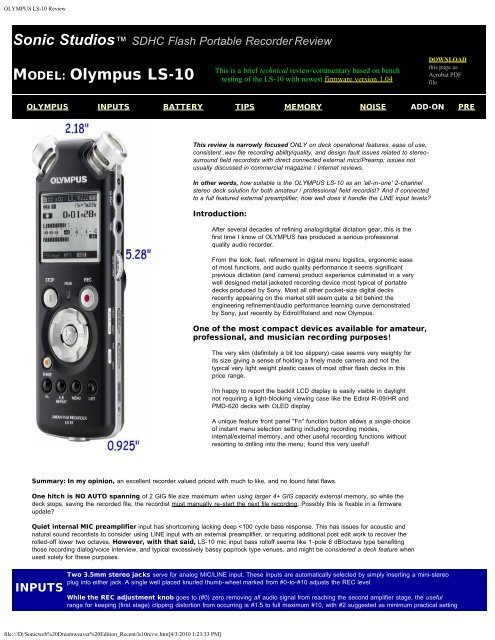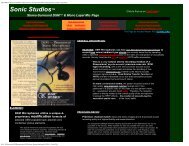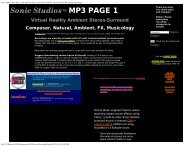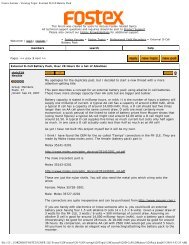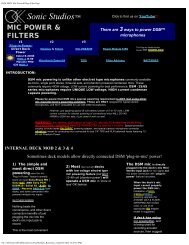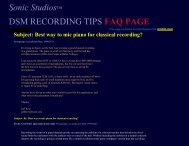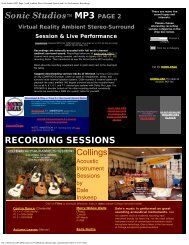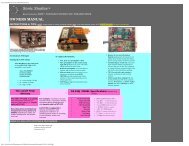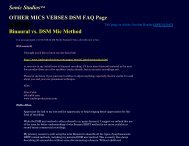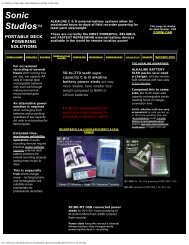Create successful ePaper yourself
Turn your PDF publications into a flip-book with our unique Google optimized e-Paper software.
<strong>OLYMPUS</strong> <strong>LS</strong>-<strong>10</strong> <strong>Review</strong><br />
<strong>Sonic</strong> <strong>Studios</strong> SDHC Flash Portable Recorder <strong>Review</strong><br />
MODEL: Olympus <strong>LS</strong>-<strong>10</strong><br />
This is a brief technical review/commentary based on bench<br />
testing of the <strong>LS</strong>-<strong>10</strong> with newest firmware version 1.04<br />
DOWNLOAD<br />
this page as<br />
Acrobat PDF<br />
file<br />
<strong>OLYMPUS</strong> INPUTS BATTERY TIPS MEMORY NOISE ADD-ON PRE<br />
This review is narrowly focused ONLY on deck operational features, ease of use,<br />
consistent .wav file recording ability/quality, and design fault issues related to stereosurround<br />
field recordists with direct connected external mics/Preamp; issues not<br />
usually discussed in commercial magazine / Internet reviews.<br />
In other words, how suitable is the <strong>OLYMPUS</strong> <strong>LS</strong>-<strong>10</strong> as an 'all-in-one' 2-channel<br />
stereo deck solution for both amateur / professional field recordist? And if connected<br />
to a full featured external preamplifier, how well does it handle the LINE input levels?<br />
Introduction:<br />
After several decades of refining analog/digital dictation gear, this is the<br />
first time I know of <strong>OLYMPUS</strong> has produced a serious professional<br />
quality audio recorder.<br />
From the look, feel, refinement in digital menu logistics, ergonomic ease<br />
of most functions, and audio quality performance it seems significant<br />
previous dictation (and camera) product experience culminated in a very<br />
well designed metal jacketed recording device most typical of portable<br />
decks produced by Sony. Most all other pocket-size digital decks<br />
recently appearing on the market still seem quite a bit behind the<br />
engineering refinement/audio performance learning curve demonstrated<br />
by Sony, just recently by Edirol/Roland and now Olympus.<br />
One of the most compact devices available for amateur,<br />
professional, and musician recording purposes!<br />
The very slim (definitely a bit too slippery) case seems very weighty for<br />
its size giving a sense of holding a finely made camera and not the<br />
typical very light weight plastic cases of most other flash decks in this<br />
price range.<br />
I'm happy to report the backlit LCD display is easily visible in daylight<br />
not requiring a light-blocking viewing case like the Edirol R-09/HR and<br />
PMD-620 decks with OLED display.<br />
A unique feature front panel "Fn" function button allows a single choice<br />
of instant menu selection setting including recording modes,<br />
internal/external memory, and other useful recording functions without<br />
resorting to drilling into the menu; found this very useful!<br />
Summary: In my opinion, an excellent recorder valued priced with much to like, and no found fatal flaws.<br />
One hitch is NO AUTO spanning of 2 GIG file size maximum when using larger 4+ GIG capacity external memory, so while the<br />
deck stops, saving the recorded file, the recordist must manually re-start the next file recording. Possibly this is fixable in a firmware<br />
update?<br />
Quiet internal MIC preamplifier input has shortcoming lacking deep
<strong>OLYMPUS</strong> <strong>LS</strong>-<strong>10</strong> <strong>Review</strong><br />
that keeps stereo channel balance within measured 0.7 dB at this low adjustment setting. Channel balance is most precision with knob at<br />
>#5 positions measured at up to 0.1 dB channel match; very good for a mechanical analog control.<br />
MIC input low/high sensitivity is set with a slide switch always active even with 'HOLD' active and when recording; a good feature from my<br />
experience. MIC power (PIP) on/off function is menu driven supplying up to +2.9 volts for powering external mics. Unfortunately, as usual for<br />
current stock flash deck models, <strong>LS</strong>-<strong>10</strong>'s PIP feature will NOT power my own DSM microphones; exception (so far) is Sony PCM-D50<br />
REC ADJUST KNOB vs. SIGNAL INPUT FOR 0dB<br />
INPUT<br />
VU FS<br />
MODES<br />
#1.5 #5 #<strong>10</strong> 96K -3 dB BW<br />
MIC<br />
HIGH<br />
MIC<br />
LOW<br />
LINE<br />
-30 dBu<br />
-8.8 dBu<br />
+24 dBu<br />
-45<br />
dBu<br />
-25<br />
dBu<br />
+8.0<br />
dBu<br />
-56 dBu<br />
-36 dBu<br />
83 - 46.5K Hz<br />
-2.0 dBu <strong>10</strong> - 46.5K Hz<br />
COMMENTS<br />
INPUT modes seem to have ~ 6 dB NON-overlapping dead<br />
zones. Not a problem with 24bit depth resolution for effect-free<br />
edit boost adjusts.<br />
MIC input 83 Hz bass rolloff benefits loud pop/rock<br />
live venue and voice type recording.<br />
MIC INPUT<br />
BANDWIDTH<br />
PLOT<br />
<strong>LS</strong>-<strong>10</strong> uses (2) AA alkaline or NiMH type cells for estimated 8-12 or <strong>10</strong>-16 hours recording time.<br />
BATTERY<br />
Advanced 'Oxy nickel' Alkaline Batteries now offered by Sony and Panasonic lasting maybe 12-16+ hours, same<br />
estimated runtime using NiMH 2600+ ma capacity rechargeable cells, and longest possible 18-22+ hours (especially if<br />
recording continuously in warm ambient) with Energizer L91 or equivalent 2900 ma. capacity photo lithium type cells.<br />
All noise tests done with <strong>10</strong>00 ohm input resistor load to ground.<br />
THE -35 dBu gain referenced input noise of the <strong>LS</strong>-<strong>10</strong><br />
is graphically shown at left with MIC PIP on/off, and with<br />
external LINE inputted PA-3SX preamplifier.<br />
ONLY the MIC PIP mode verses LINE input showed<br />
any noise performance differences.<br />
Using internal/external flash memory mode,<br />
LCD backlight on/off, or 24bit 44.1K verses 96K<br />
recording modes had NO effect on measured noise<br />
performance. So feel confident using these <strong>LS</strong>-<strong>10</strong> deck<br />
features with no liability on noise performance<br />
whatsoever.<br />
The (-dBu) number shown in parenthesis for each<br />
recorded mode is the total RMS power over entire<br />
measurement frequency.<br />
The <strong>LS</strong>-<strong>10</strong> mic input in LOW sensitivity with REC adjust<br />
file:///D|/<strong>Sonic</strong>web%20Dreamweaver%20Edition_Recent/ls<strong>10</strong>revw.htm[4/3/20<strong>10</strong> 1:23:33 PM]
<strong>OLYMPUS</strong> <strong>LS</strong>-<strong>10</strong> <strong>Review</strong><br />
knob set at #9 was used, while the LINE input was<br />
measured adjusted to #8 with external PA-3SX at<br />
highest #3 gain.<br />
HERE is a 15 second .wav file of <strong>LS</strong>-<strong>10</strong>'s mic/line input noise with 5 seconds of MIC<br />
PIP=OFF/ON/LINE w/PREAMP having PIP as depicted in the noise graph above, but amplified by 35<br />
dB so very audible.<br />
Up to 16 GIG external SDHC<br />
type memory card now <strong>LS</strong>-<strong>10</strong><br />
compatible with newest v1.04<br />
firmware upgrade.<br />
Although NO AUTO spanning<br />
between the two memories,<br />
internal 2 GIG/external memory<br />
is most quickly manually<br />
selected with the 'Fn' button<br />
assigned to internal/external<br />
memory function.<br />
Photo of both newer Edirol/Roland R-09HR and<br />
reviewed Olympus <strong>LS</strong>-<strong>10</strong> flash decks with the PA-3SX<br />
preamplifier.<br />
The small size of the preamp is exactly same<br />
width/depth as the slim <strong>LS</strong>-<strong>10</strong> attaching very nicely (with<br />
adhesive Velcro) to the back of either of these decks.<br />
While the <strong>LS</strong>-<strong>10</strong> internal preamplifier is adequate for<br />
many common recording requirements, using an<br />
external preamp has advantage for extended low bass<br />
response, much less low frequency noise, for powering<br />
my own DSM mics, and useful for some other PIP type<br />
electret or self-powered mics giving lowest possible<br />
distortion with improved 24bit depth audio detail.<br />
External <strong>LS</strong>-<strong>10</strong> SDHC memory can now be up to 16 GIG SDHC card capacity with newest 1.04 firmware<br />
upgrade.<br />
SanDisk ULTRA II SDHC<br />
Most everyone using this type for audio<br />
recording has good experiences.<br />
Kingston Elite Pro SDHC<br />
Most everyone using this type for audio<br />
recording has good experiences.<br />
Kingston 8 GIG SDHC (type 6)<br />
Used this type for R-09HR/<strong>LS</strong>-<strong>10</strong> deck<br />
reviewing and bench testing so far with good<br />
experience.<br />
Transcend SDHC<br />
NOT everyone using this type for audio<br />
ADVISORY: As with<br />
most memory<br />
products, most<br />
consistent performance is<br />
with purchasing name<br />
brand showing suitable<br />
specifications for your<br />
application, AND verified<br />
reports from satisfied<br />
users of same deck<br />
model/firmware who are<br />
A<strong>LS</strong>O recording at the<br />
exact same file rates you<br />
intend to use.<br />
Also be aware that<br />
manufacturers of flash<br />
memory sometimes<br />
change internal controller<br />
IC that may not work as<br />
previously made same<br />
model cards.<br />
This has most<br />
recently happened with<br />
Transcend made flash<br />
with many buyers<br />
disappointed using same<br />
model cards working<br />
flawlessly for most with<br />
same model<br />
Might be BEST TO NOT USE<br />
ACCELERATED super speed flash memory<br />
technology for audio recording purposes.<br />
Advanced flash with acceleration<br />
write/read modes using data burst<br />
techniques might be speedier for writing/reading<br />
non-continuous written camera files. Noncontinuous<br />
burst protocol modes sometimes disrupt<br />
reliable continuous mode audio recording on some<br />
decks/firmware versions, and certainly offer NO<br />
advantages for continuous written audio recording.<br />
Memory with best chance of satisfaction for<br />
audio purposes have published continuous write<br />
speeds in excess of 2 Mbytes/sec. Best to avoid<br />
buying memory cards showing only (number)X<br />
BURST write/read ratings.<br />
file:///D|/<strong>Sonic</strong>web%20Dreamweaver%20Edition_Recent/ls<strong>10</strong>revw.htm[4/3/20<strong>10</strong> 1:23:33 PM]
<strong>OLYMPUS</strong> <strong>LS</strong>-<strong>10</strong> <strong>Review</strong><br />
recording has good experiences.<br />
deck/firmware, but using<br />
previous Transcend<br />
production runs of same<br />
model card.<br />
TIP: Freshly format the flash card INSIDE the deck after all needed recordings have been<br />
successfully transferred leaving no wanted files for best card performance with each new use.<br />
ALWAYS format new cards, format after deck firmware upgrades, and whenever cards are removed from the deck for<br />
purpose of transferring files with a separate card reader. NEVER computer format flash as deck adds specific required<br />
<strong>LS</strong>-<strong>10</strong> file folders to the card.<br />
© 7/1/2008 <strong>Sonic</strong> <strong>Studios</strong>; All rights reserved; Updates expected from time-to-time.<br />
What's on <strong>Sonic</strong> <strong>Studios</strong> Web Site? (Click underlined text, and navigation photos)<br />
Home Page<br />
DSM<br />
Patented Stereo-Surround Microphone<br />
Technology<br />
Passive DSM Mic Powering/Bass Filters<br />
Eyegear/Headband/HRTF Baffle<br />
mountable matched omni mics<br />
Stops wind blast noise; transparent<br />
acoustic design; records real wind<br />
sounds<br />
for MD, DAT, CF, HD, and Video Field/Event/Studio Recording<br />
Battery Powered-Portable Mic Preamplifiers<br />
High-definition, low noise, very wide<br />
bandwidth preamp designs to fit any<br />
field/event/studio application using DSM<br />
stereo-surround mics.<br />
HRTF<br />
RECORDING<br />
Stereo-Surround Omni<br />
Mic Baffle for Stand,<br />
Fishpole, Studio Boom,<br />
and Ceiling<br />
RECORDING ACCESSORIES<br />
Portable<br />
Deck<br />
Power<br />
Solutions<br />
Patch/Adapter<br />
Cables<br />
MONO ONLY 'Lombardo'<br />
Lapel Mic for interview,<br />
Narration, Lecture, and<br />
clip-on acoustic instrument<br />
Recording<br />
Field/Studio<br />
Monitoring<br />
Headphones,<br />
<strong>Review</strong>s<br />
DSM Magazine <strong>Review</strong>s<br />
Recording Tips YouTube USA Toll Free: 1-877-347-6642<br />
FAQ Index Page<br />
Pro Customers +<br />
Links<br />
Customer<br />
Comments<br />
A Few Other Links<br />
About <strong>Sonic</strong> <strong>Studios</strong><br />
Sample DSM<br />
Recordings Page<br />
Film-Video-Games<br />
Credits Page<br />
Telephone #: 541-459-8839<br />
E-mail:<br />
Guy<strong>Sonic</strong>@aol.com<br />
Mail Ordering Options<br />
AVOID ACCIDENTAL E-MAIL SPAM<br />
DELETION:<br />
PLEASE .................. ALWAYS INCLUDE<br />
an appropriate SUBJECT LINE in all e-mail<br />
correspondence.<br />
© Copyright 2007 <strong>Sonic</strong> <strong>Studios</strong> All rights reserved.<br />
file:///D|/<strong>Sonic</strong>web%20Dreamweaver%20Edition_Recent/ls<strong>10</strong>revw.htm[4/3/20<strong>10</strong> 1:23:33 PM]
<strong>OLYMPUS</strong> <strong>LS</strong>-<strong>10</strong> <strong>Review</strong><br />
file:///D|/<strong>Sonic</strong>web%20Dreamweaver%20Edition_Recent/ls<strong>10</strong>revw.htm[4/3/20<strong>10</strong> 1:23:33 PM]


